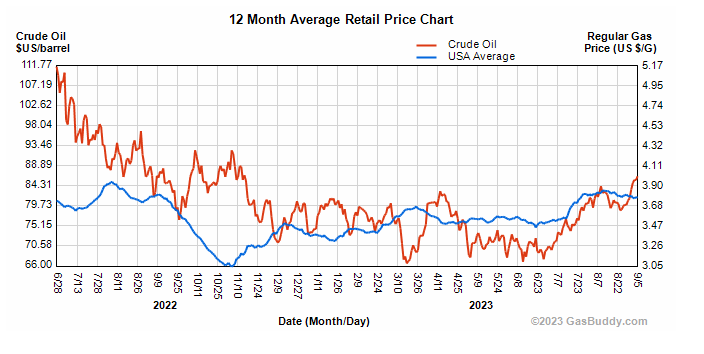Gasoline prices in the United States are at the highest level seen at this time of year in over a decade ― and could soon climb even higher.
After a summer of increases that plateaued only briefly over the past two weeks, prices may soon lurch upward again in response to cuts to the global supply or if more disastrous storms lash the U.S. Gulf Coast.
The price at the pump typically tracks the cost per barrel of crude oil, which is the main ingredient in fuel for automobiles.
On Tuesday, the price of Brent crude ― the benchmark for oil refined in Western Europe ― surged past $90 per barrel for the first time this year. The spike came shortly after the world’s top two oil exporters, Saudi Arabia and Russia, announced plans to cut back on supply. The price of West Texas Intermediate ― the benchmark for U.S. oil ― increased by a slightly larger percentage to just over $87.
In July, the hottest month ever recorded, scorching heat squeezed supplies, forcing Gulf Coast refineries that turn crude into gasoline to shut down amid triple-digit temperatures. In response, the average national price of unleaded gasoline jumped by roughly 30 cents per gallon to $3.83 at the beginning of August. Many of those refineries ran day and night throughout August to ramp up production.
By Sept. 6, a few pennies fell off the average national price, dropping to $3.80, according to American Automobile Association data. While the price was down compared to last month or even last week, the information service GasBuddy found that gas cost roughly 3 cents more than this time last year despite a drop in the rate of U.S. inflation overall.

“The national average fell to its lowest level since July ahead of Labor Day, even as oil prices rose last week to the highest level since last November,” Patrick De Haan, head of petroleum analysis at GasBuddy, said in a statement.
Refineries will switch later this month to producing winter-grade gasoline, which contains more butane and is generally cheaper to make, meaning prices could come down even more by the end of the month. But that depends on whether further heat waves or hurricanes hit the Gulf, where most of the U.S. refineries are based.
“Any disturbances that threaten the Gulf could delay any decline between now and then, creating a bit of a bumpy ride for the next week or two before more relief arrives toward late September,” De Haan said.
Gas prices are currently highest in Illinois, the Western states and the Northeast.
In the United States’ increasingly partisan national politics, it is something of a tradition to blame the sitting president for higher gas prices. This is particularly true for President Joe Biden, whose Republican opponents have drawn dubious links between the administration’s proposed regulations on future oil and gas production and the price swings that analysts widely attribute to other forces in the global market.
Still, the White House last year twice took the unusual step ― once in March, then again in October ― of tapping into the nation’s strategic oil reserve, releasing 180 million barrels per day for months on end. The move helped lower prices, but reduced the stockpile to its lowest levels since the 1980s.
The Biden administration announced plans to begin refilling the storage tanks in June. But the Department of Energy postponed those plans last month as oil prices surged past $80 per barrel, with officials saying they wanted to wait to get a better deal for U.S. taxpayers. The reserve is now roughly half full.
Oil prices will pinch hardest outside the United States. Americans pay the second-lowest gas prices in the Organization for Economic Cooperation and Development, the 38-nation club of rich countries, behind only Colombia. Like the U.S., Norway, which pays the highest prices, is a major producer of oil. But the Nordic nation’s high taxes on fuel have helped fund a massive buildout of charging stations, helping to propel electric vehicles to 80% of new cars sold last year.
